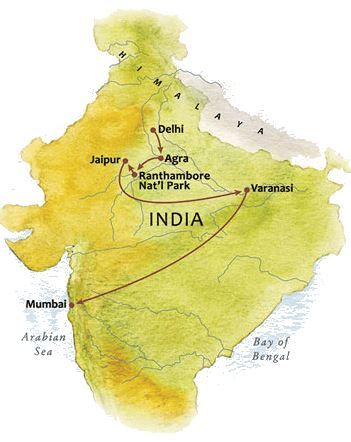13-Nights The Soul of India from $28,450
Micato Safaris
OFFER ID 1286828
Into Innermost India
Months, years, decades could profitably be spent exploring India’s 812 million richly varietal acres. But few of us have time to follow our bliss indefinitely, so we created The Soul of India to provide a thoughtful, succinctly paced, and delightful look at some of the continent’s most eye-brightening sights.
We begin in Delhi, “always interesting to all mankind” as Ved Mehta quoted a taxi wallah as saying. Then we pay homage to the Taj, whose praises we sing throughout. We peacefully search for what is perhaps the most splendorous animal on earth in Ranthambore National Park, wander the glamorous Pink City of Jaipur, and witness intense spiritual devotion at Varanasi, “the most supremely potent pilgrimage site on earth.” We end in the supercity of Mumbai, a distillation of India’s incredible energy and ambition, its daily familiarity with and deep attachment to its many thousands of years of history.
Highlights
- The glowing grandiosity of the Taj Mahal; Jaipur’s magnificent palaces; Varanasi’s deeply affecting spiritual luminosity; and the fascinating megacity of Mumbai.
- Sightings of the Emperor of Beasts, the Royal Bengal tiger, in Ranthambore National Park.
- Unstinting services of a Micato Travel Director, and our one-of-a-kind Concierge Service.
- Meetings with India insiders from all walks of life, and special entree to palace quarters.
- Some of Condé Nast Traveler and Travel + Leisure’s World’s Best hotels: Jaipur’s stately Rambagh Palace, Agra’s sublime Amarvilas, and Ranthambore’s winsomely engaging Vanyavilas.

13 nights from $28,450 per person
Vacation Details
* This departure has been designated a guaranteed departure by the operator, meaning that the minimum number of guests has been met, although still subject to weather and other conditions.
1. Accommodations
First-class hotel accommodations based on twin-bedded rooms with private bath or showers—the categories assigned to hotels reflect the opinion of Micato Safaris.
2. Meals
Three meals daily per the itinerary, based on evening arrivals on Day 2.
3. Air Transportation
Your travel agent should arrange international flights or Micato can refer you to its preferred purveyor of air tickets. Internal African flights on safari must be purchased through Micato.
4. Luggage
Tour rates include the transport and handling of two pieces of luggage per per- son per airline regulations. Guests are urged, however, to travel with only one medium-size suitcase. On certain flights within Africa, strict luggage restrictions apply; details are provided in tour documentation. Luggage and personal effects are at owner's risk throughout the tour.
5. Taxes
The tour program includes hotel taxes as imposed by city and state govern- ments, entrance fees to National Parks and Game Reserves, and airport taxes for intra-country flights. International airport taxes are not included.
~ Please Note: If a minimum number of travellers is not reached, Micato may provide local guides in each location in place of a Micato tour or safari director. Extensions are locally guided. ~
Not Included in Quoted Tour Rates:
Cost of obtaining passports, visas, travel insurance, excess baggage charges, items of a personal nature such as drinks, laundry, communication (calls, faxes, emails, etc.), international airport departure tax (to be paid in U.S. dollars or acceptable foreign currencies), and deviations from the tour.
All fares are quoted in US Dollars.
Reference this number when contacting our agency so we may better serve you. Also keeping this number handy will allow you to locate this document again quickly.




